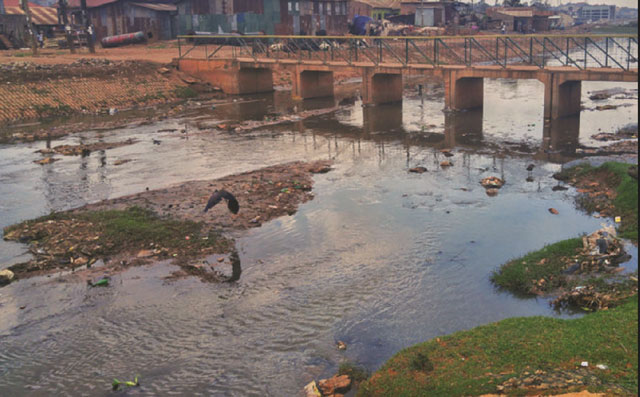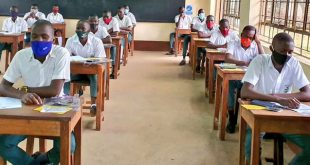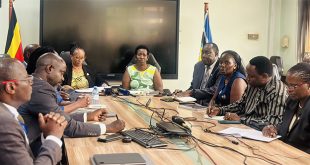
CHOLERA: Why the unexpected outbreak happened
Kampala, Uganda | FLAVIA NASSAKA | Emma Tagobya; the Local Council Chairman of Sembule B Zone of Kabowa Parish, Rubaga Division has been quite busy lately – battling a cholera outbreak in his area.
Sembule B Zone is right on the edge of Kampala city along Entebbe Road in the Ndeeba area but it looks quite rural with its unpaved roads that billow clouds of dust in dry weather and become rivers of flood water when it rains.
Located in a low-lying water-clogged marshland a few minutes south of the city, the only reminders of urban life in Sembabule B are the mounds of uncollected garbage around the many small, low cost bungalows, piled next to each other without plan, and looking unkempt. Cholera is common.
When we spoke to Tagobya on Jan.11, two people had already died in the area and one was a confirmed cholera case. Another 16 people suspected to be infected with cholera were being monitored in hospital. A couple and their four children had just been reported to have developed symptoms of cholera.
We spoke on phone and when Tagobya put our call on hold, we could hear him telling someone to go pick the patients. Then he turned to a team of volunteers who needed him to authorise them to use the ambulance.
Tagobya blames the cholera outbreaks on the lack of toilets. His area, the second most populated parish after Nateete in Rubaga Division of Kampala, has 20,000 people but only two public toilets which too have long been closed. Most household do not have private toilets. Poor solid waste disposal is a major contributor to the spread of cholera, which is transmitted through drinking or eating foodstuffs contaminated with a bacterium called Vibrio cholera which thrives in faeces. An infected person will die in a matter of hours if they don’t receive immediate medical attention. They develop high fevers, severe diarrhea, dehydration and seizures may occur in severe cases.
For a week, Tagobya’s office had been operating as a call center for reporting anyone who develops symptoms after the highly infectious bacterial disease hit his area.
That morning, he said, he had brokered a deal with one of his residents to provide the community with a private toilet that they could use at least until they nip the scourge in the bud. The Shs200,000 deal also involved emptying the facility which was already filling and putting in place a supervisor to ensure that it’s clean at all times.
Health managers panic
But the disease has not just put the people of Kabowa in panic mode but healthcare managers, politicians and Kampala city managers too.
In just three days, the Minister of State for Health In-charge of Primary Health Care, Dr. Joyce Moriku Kaducu, had visited the place twice. She told The Independent that her first visit was meant to do a spot check on the area, see the triggers and come up with specific solutions that can work for the area.
When she returned, she distributed recovery kits to people who had been affected by the disease and had since been discharged from hospital.
Kampala Lord Mayor Erias Lukwago visited the area, gave some of the residents who are among the most desperate urban poor some cash, bars of soap, and put in place an ambulance to transport patients.
The Minister of State Minister for Kampala, Benna Namugwanya, had also been there and participated in a gang cleanup of the area together with the locals. She said ‘Bulungi bwa nsi’, as the activity is locally known, can help to ensure that the area is kept clean and keep such diseases as cholera at bay. She proposed to residents to make it a norm to set aside a day every month to do this kind of general cleaning.
She also banned the sale of unpackaged cold drinks and fresh eats in the area saying the ban will also extend to other parts of the city as a bigger plan to regulate the sale of fruits is still being discussed.
As regards garbage collection, she said Kampala City Council Authority had asked the concessionaire – Home Klean to increase the number of the times they pick rubbish from Kabowa and similar areas that risk getting affected by cholera.
It appears the main components of the Ministry of Health’s Cholera Elimination Strategy were kicking in early. These focus mainly on behavioral change and enforcement
But, while all the visitors to the area agreed that it is time to act on the national clean up days and sensitising people more on the need to stay in a clean environment, people knowledgeable about the area say the managers are tackling a wrong issue, the real issue is the toilet.
Tagobya told The Independent that the real challenge that baffles them is how and where to dispose of fecal matter.
“You know our toilets here are polythene bags, buckets and the Nalukolongo channel. We have no public toilets and landlords don’t provide private toilets for their tenants. We can’t stop cholera in such a situation,” he said when he came online again.
Failing government projects
The Nalukolongo Channel is a small stream that flows through the area right from the Kabaka’s Lake in Ndeeba in the city where it starts before finally joining the Lubigi Channel which ends in the major Lubigi wetland along Masaka Road.
The Nalukolongo Channel is critical to the health of residents in the city suburbs of Rubaga, Natete, Ndeeba, and Nalukolongo. But as Tagobya explained, it is clogged with silt, sewage, and debris and requires major de-silting and expansion.
“That Nalukolongo channel is supposed to be four feet wide but it’s now less than a foot wide. All those polythene bags there are full of faeces,” he said as he pointed at mounds of black polythene and sludge stuck in the channel, “I mobilised residents to desilt it (but) we couldn’t handle the filth.”
Widening the Nalukolongo channel was first mooted in 2009 when the World Bank gave Kampala City Council (KCC) US$10 million for the job. However, KCC diverted the money to other uses.
In 2014, Kampala Capital City Authority (KCCA) again got money from the World Bank under the US$183.7 million Kampala Institutional Infrastructure Development Project –I (KIIDP-I). The money was to expand and line the 5.5 km primary Nalukolongo channel, and 0.7 km of secondary channels.
Five year later, no work had been done. Informed sources say local leaders are resisting an alleged move by consultants hired by KCCA to inflate the cost of compensation of project affected persons (PAPs). The consultants say that requires Shs8 billion but the local politicians say Shs5 billion is needed. It is not clear how the figure was reached by local leaders but compensation of PAPs on public works projects is a known area for corruption. As the wrangle over money rages, the locals continue to suffer.
Tagobya says floods in the already swampy slum make it difficult to construct the cheapest form of toilets; the squat pits.
Tagobya is no expert but Engineer Obed Lutaakome who is an expert on waste management also appeared to agree when he spoke to The Independent.
Lutaakome said the traditional pit latrine which is cheap and mostly used by people in slum areas has been found to pollute the environment. In Kampala, for example, only about 70 percent of the city residents have access to clean water. The rest use water that is sometimes contaminated by pit latrines.
Lutaakome said, however, the modern flush or waterborne toilets are also not a good idea for low income earners because of the cost of maintenance that comes with them.
Instead, he recommended lined up toilets built with a septic tank that can be emptied whenever it fills. The beauty with this type, he says, is that innovations such as employing chemicals to dry the fecal matter can be used which saves users from the cost of emptying.
 The Independent Uganda: You get the Truth we Pay the Price
The Independent Uganda: You get the Truth we Pay the Price


